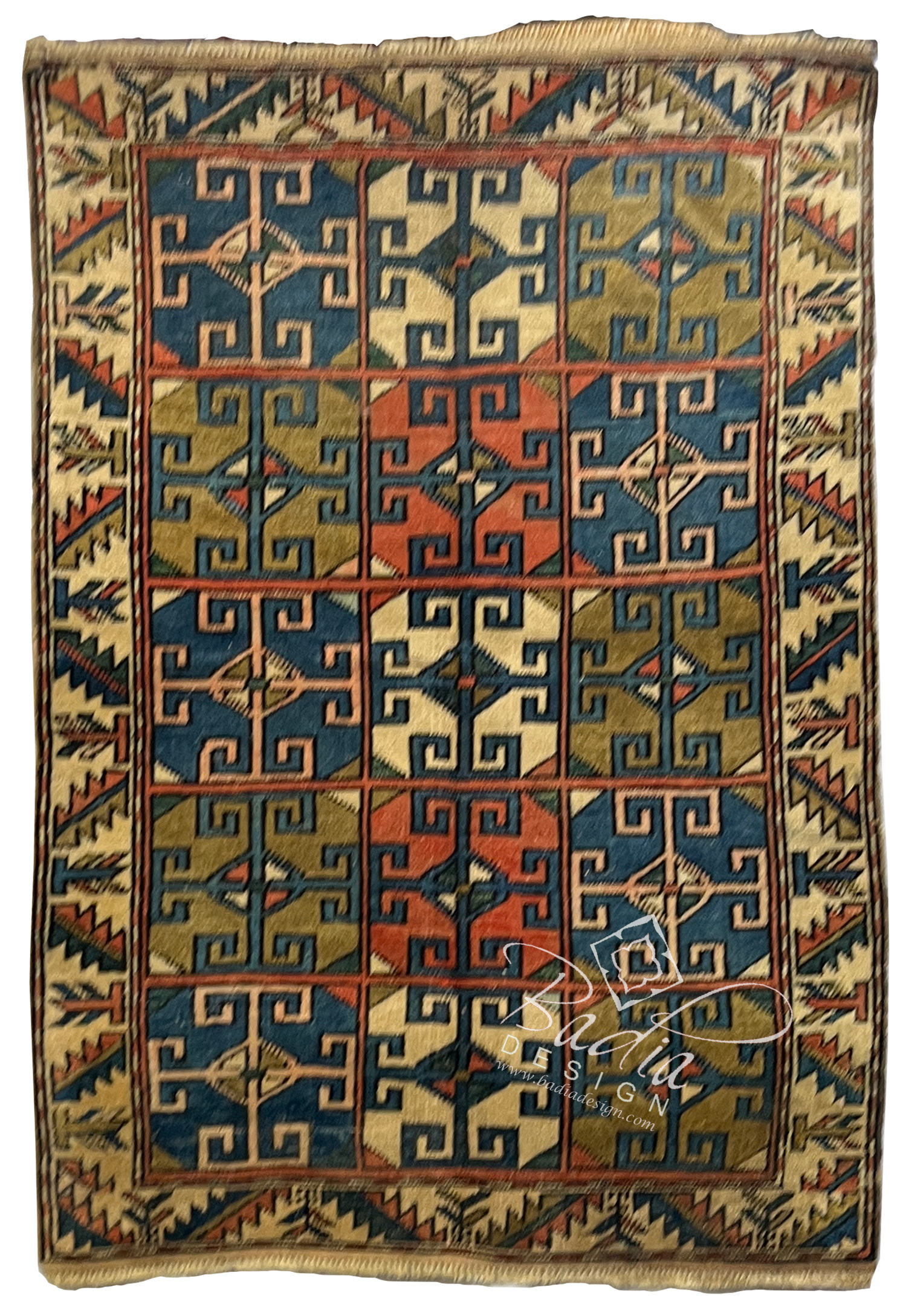Product Description
Green Multi-Color Turkish Rug with Geometric Designs
Enhance your home with the vibrant beauty and craftsmanship of a handwoven Turkish Rug. Featuring intricate patterns, rich colors, and traditional motifs, each rug tells a story of heritage and artistry. Made from high-quality wool and natural dyes, these rugs offer both durability and elegance, perfect as a focal point or accent piece in any room. Whether for a contemporary or classic space, our colorful Turkish Rugs add warmth, character, and timeless style to your décor. A stunning blend of tradition and modern design.
Learn about the History of Turkish Rugs below.
Size: 33" W x 52" H
Style #: TKR043
Please contact us for pricing and availability:
Badia Design Inc.
Tel: 818-762-0130
Email: info@badiadesign.com
Note: All of our rugs are handmade by our artisans. There may be some minor imperfections which should not be considered as damaged products.
The History of Turkish Rugs: A Tapestry of Culture, Art, and Tradition
Turkish Rugs are more than just a beautiful item of home decor. They represent a centuries-old tradition of artistry, craftsmanship, and cultural expression that spans diverse regions, communities, and empires. With their roots in the ancient civilizations of Anatolia, Turkish Rugs hold a prominent place in the history of textile production, weaving together influences from nomadic tribes, Islamic art, and the Byzantine and Ottoman empires. Here’s an exploration of the captivating history of Turkish Rugs, tracing their evolution from ancient times to the modern era.
Early Beginnings: The Origins of Turkish Weaving
The art of rug weaving in Turkey dates back more than 2,000 years. Evidence of early weaving techniques and designs has been discovered in archaeological sites across Anatolia, the region now known as modern Turkey. This area has been a crossroads for various civilizations, including the Hittites, Phrygians, and Urartians, each contributing to the region’s artistic development. Nomadic tribes played a crucial role in establishing the weaving tradition, crafting rugs for practical purposes like floor coverings, tent decorations, and saddle bags.
Rugs in these early periods were largely influenced by the nomadic lifestyle and served as both functional and symbolic items. The materials were natural fibers such as wool, which was abundant due to the region’s robust sheep farming. These early rugs were typically woven on horizontal looms that could be easily transported by nomadic tribes. The patterns and motifs often included geometric shapes, animals, and symbolic designs representing aspects of tribal life and spirituality.
The Seljuk Era: The Birth of Anatolian Rugs
In the 11th century, the Seljuk Turks conquered Anatolia and brought with them their distinct artistic and cultural influences, which significantly impacted rug weaving in the region. The Seljuks, who were skilled weavers, introduced new techniques and designs, and under their rule, weaving evolved into a highly respected craft.
The Seljuk period saw the first establishment of carpet weaving as a structured trade, with workshops producing rugs in larger quantities for commercial purposes. Rugs from this era, often referred to as "Anatolian rugs," featured intricate patterns, medallions, and symmetrical designs that would later become foundational in Turkish Rug Design. The dyes were vibrant, using natural sources like madder root for red and indigo for blue, creating lasting colors that remain vivid even in antique pieces today.
Ottoman Influence: A Fusion of Art and Power
The Ottoman Empire’s rise in the 15th century brought about one of the most prosperous periods in Turkish Rug Weaving. Ottoman sultans promoted art and craftsmanship, establishing royal workshops where the most skilled artisans worked to create exceptional textiles, including carpets. Ottoman rulers were known for their patronage of the arts, and weaving became an esteemed profession with royal workshops producing rugs for palaces, mosques, and affluent patrons across the empire.
The Ottoman period introduced several notable changes to Turkish Rug Design. Motifs became more elaborate and stylized, incorporating floral patterns, arabesques, and calligraphic elements inspired by Islamic art. Prayer rugs, featuring a niche or "mihrab" design symbolizing the direction of Mecca, also became popular during this period. The Ottomans used a wide variety of materials, including silk and wool, and even gold and silver threads in some luxury pieces. Many of these masterpieces were exported to Europe, where they adorned the homes of the wealthy and influential, cementing the global reputation of Turkish Rugs.
Regional Styles: Diversity in Turkish Rug Designs
Turkish Rugs are not monolithic in style; instead, they reflect the distinct regional identities of different parts of Anatolia. Each region developed unique weaving techniques, patterns, and color schemes based on local materials and cultural influences. Some of the most famous styles include:
-
Hereke Rugs: Known for their luxurious quality, Hereke rugs were originally produced in the town of Hereke near Istanbul. They are distinguished by their fine silk and wool materials and are often intricately designed with floral and medallion motifs.
-
Oushak (Uşak) Rugs: Originating from the town of Uşak in western Turkey, Oushak rugs became popular for their large, bold floral patterns and soft color palettes. These rugs were particularly favored in Europe and were often depicted in Renaissance paintings.
-
Konya Rugs: The city of Konya, located in central Anatolia, is known for producing rugs with geometric patterns and earthy tones. Konya rugs are influenced by nomadic designs and often feature symbols that represent fertility, protection, and spirituality.
-
Bergama Rugs: Made in the Bergama region in western Turkey, these rugs are known for their thick wool pile and vibrant colors, often incorporating deep reds, blues, and yellows.
-
Yörük Rugs: Named after the Yörük tribes of southwestern Turkey, these rugs reflect the bold, geometric patterns and rich colors characteristic of nomadic traditions.
Symbolism in Turkish Rugs: A Language of Motifs
Turkish Rugs are imbued with symbolic meaning, and each motif represents specific cultural beliefs, values, and aspirations. For instance, the tree of life symbolizes immortality and connection to the divine, while the star or medallion motif often signifies protection. Animal motifs like birds, butterflies, and deer represent freedom, beauty, and abundance. Some designs are even thought to have magical properties, serving as talismans to ward off evil spirits or bring good fortune to the home.
These symbols are often woven into the rugs without direct representation but through abstract forms and stylized designs. The motifs vary widely across regions and tribes, each with its own set of symbols and meanings. Learning to read these motifs allows one to appreciate the cultural richness and storytelling embedded within each piece.
Turkish Rugs in Modern Times: Preservation and Revival
The art of Turkish Rug Weaving has faced various challenges in the modern era. The introduction of machine-made carpets in the 20th century affected traditional rug production, and many artisans struggled to compete with cheaper alternatives. However, there has been a revival in recent decades as collectors, designers, and enthusiasts around the world have shown renewed interest in Handwoven Turkish Rugs.
Today, efforts are being made to preserve this ancient craft. Government initiatives, artisan cooperatives, and cultural organizations work to protect the Heritage of Turkish Weaving, supporting local weavers and educating new generations in traditional techniques. Authentic Turkish Rugs remain highly sought after, valued not only for their beauty but for the cultural and historical significance they carry.
Conclusion: The Enduring Legacy of Turkish Rugs
Turkish Rugs are more than mere floor coverings—they are historical artifacts that tell the story of a civilization’s journey through time. From the nomadic tribes of ancient Anatolia to the sophisticated artisans of the Ottoman Empire and the modern-day weavers who continue the tradition, Turkish Rugs embody a legacy of creativity, resilience, and cultural pride. They serve as a bridge between past and present, connecting people to a world of symbolism, artistry, and tradition.
In a world where mass production and digital technology dominate, The Art of Turkish Rug Weaving stands as a testament to the timeless appeal of handmade craftsmanship. Whether as functional objects or as collector’s items, Turkish Rugs continue to captivate with their intricate designs, vivid colors, and profound cultural significance, securing their place in the rich tapestry of human history.









